THE cassava, also known as cassava, maniva, cassava, waipi and castelinha, it is a plant of great importance in terms of world food, being the most important crop after wheat, rice, corn, potatoes and barley. This plant is characterized by being an important source of starch, being used both in human and other animal food.
Read too: Recommendations for healthy eating
Cassava characteristics
Cassava is a plant of family Euphorbiaceae, belonging to the gender Manihot and kind Manihot esculenta. The gender Manihot presents 109 species, but only the species Manihot esculenta it is grown for commercial purposes, which occurs in more than 100 tropical and subtropical countries.
Cassava is a species shrub, woody and perennial, which can reach up to five meters in height. Features sheets simple, constituted by blade and petiole, with variable number of lobes and purple to dark green coloration. O stalk it may be erect and may or may not have branches.
Cassava presentsroots tuberous type, which are cylindrical or conical in shape and light brown in color, the inner tissue being white or yellowish. The plant develops from five to 10
starchy roots, with a length varying between 15 cm and 100 cm (there are records of cassava roots with more than four meters in length) and a diameter of three to 15 cm. Cassava roots weigh, on average, four to seven kilos, but can weigh up to 40 kg. It has male and female flowers in the same inflorescence, and the fruit it is triloculated and dehiscent.
Cassava is planted using pieces of its stem, denominated stakes. The stakes, which must be 15 cm to 25 cm, are placed in holes, where they develop and give rise to a new individual. This species develops well in soils poor and has good resistance to pests and diseases. Sandy soils or those that are permanently flooded are not suitable for cultivation, and harvesting is done manually.
Wild cassava and sweet cassava
Cassava, despite all its importance in food, is a cyanogenic plant, which is characterized by the presence of hydrocyanic acid, an extremely toxic substance. Cyanogenic compounds can be responsible for problems such as hyperthyroidism and konzo, an irreversible disease that manifests itself in the form of paralysis. Considering the hydrocyanic acid levels, cassava can be divided into two groups: sweet cassava or table cassava and wild or industrial cassava.
The sweet cassava is sold in supermarkets and fairs. According to Embrapa, it has low levels of hydrocyanic acid (HCN) in the raw pulp of fresh roots, generally below 50 mg/kg of pulp. Wild cassava has high levels of acid, therefore, it must be carefully prepared to ensure the elimination of hydrocyanic acid and safe consumption of the food. Wild manioc is used in the industry for the manufacture of flour.
It is noteworthy that wild cassava and sweet cassava are two types of the plant that do not have morphological characteristics that allow them to be effectively differentiated. Ideally, if the farmer does not know the origin of the cassava, a laboratory test to determine the hydrocyanic acid content.
Nutritional values

Cassava is a plant that has great nutritional value. The roots, the most consumed part of the plant, have a large amount of starch and are therefore rich in carbohydrates and an excellent source of calories. It is estimated that a kilo of cassava can provide around 1460 cal.
The root has a low amount of proteins, but has vitamins, such as Vitamin C, and minerals, like calcium, phosphor and iron. Cassavas that are yellowish in color also have beta-carotene, a precursor to vitamin A. Cassava is also rich in fibers and has little fat.
Read more: Importance of rice and beans - it has all the essential amino acids for the human body
Importance of cassava

Cassava is a plant of great importance worldwide, being able to increase food security in developing countries. Its root stores a lot of starch, so it is an important source of energy. In addition, cassava root is rich in calcium, phosphorus and vitamin C. Cassava root is used in the manufacture of flour and manioc flour, in addition to being consumed in different ways, such as boiled and fried.
It is worth noting that it is not only the cassava root that has nutritional value, the leaves are a good source of protein and are rich in amino acid lysine. The ground cassava leaf is used, for example, in the manufacture of a typical dish of Pará cuisine known as maniçoba.
Cassava is not used exclusively for food. This plant is used in the production of ethanol, biodegradable plastics, plywood and cosmetics, and in the textile industry. Cassava is also used to make animal feed.
By Vanessa Sardinha dos Santos
Biology teacher

